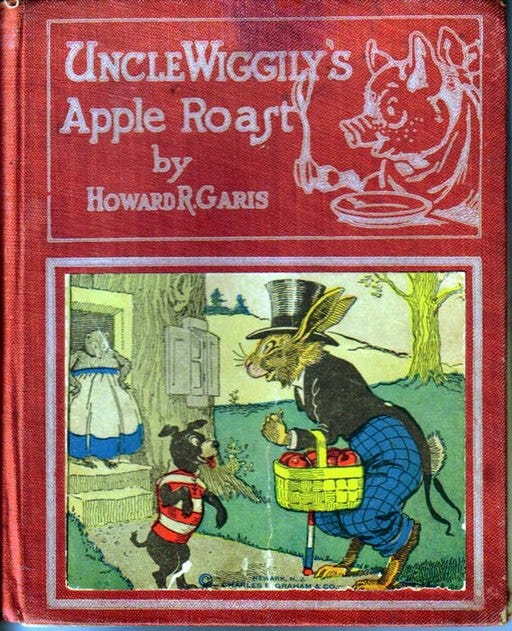It’s Spring and time to talk white rabbits.
No, not Alice in Wonderland or even the Easter Bunny…Uncle Wiggly.
You might remember playing this board game as a young child just starting school. Or you might still play it with your children or grandchildren. Uncle Wiggily is a “beginners” board game. It may not be an exciting game for adults to play, after all it is rated ages 4-7, but it teaches the basics of board games. Thanks to Uncle Wiggily, many preschool-aged children learned numbers, practiced reading and counting skills, and learned how to move forward, and be sent back, without too much grumbling.
But first, there were the books about Uncle Wiggily. That’s really how it all began.
In January 1910, the first Uncle Wiggily story appeared in the Newark News (NJ) as bedtime stories. Written by Howard R. Garis (1873-1962), the series of Uncle Wiggily stories were in the newspaper daily (except Sundays) until 1947. Garis wrote over 15,000 stories about the elderly, gentleman rabbit whose full name was Uncle Wiggily Longears. Uncle Wiggily along with friends, Nurse Jane Fuzzy Wuzzy, Baby Bunny, Alligator, the Brown Bears, and Dr. Possum, entertained children for decades.
In addition to the newspaper stories, Howard R. Garis along with his wife, Lilian C. Garis (1973-1954) wrote children’s books published by the Stratemeyer Syndicate of East Orange, N.J. Garis wrote under various pseudonyms and was the author of the Bed Time Series, the Mystery Boys Series and The Curlytop Series, among others. Lilian Garis, as Laura Lee Hope, wrote books in The Bobbsey Twins Series and Motor Girls series. Together they are credited with writing close to 1000 books for children.
Their books were top sellers of the time.
In 1916, Milton Bradley (Springfield, MA) introduced the first Uncle Wiggily game based on the adventures of Uncle Wiggily Longears stories.
The instructions originally printed in the box lid give the story behind the game:
“Uncle Wiggily Longears is an old rabbit gentleman who lives in a hollow stump bungalow in the woods, with Nurse Jane Fuzzy Wuzzy, his muskrat lady housekeeper. Uncle Wiggily has rheumatism, and starts for Dr. Possum’s house, No 151 Green Moss Avenue on the other side of the forest. Uncle Wiggily wants to be cured of his rheumatism. The object of the game is to get Mr. Longears safely to the doctor’s and whoever first does this, wins.”
Movement is determined by the directions on the red and yellow cards. The yellow cards have a printed number on them and short directions that rhyme. The red cards are the danger ones, of course. They send a player back spaces!
Ultimately, Uncle Wiggily reaches Dr. Possum’s house at #151.
Over the years, Milton Bradley changed the design of the game board and playing pieces. At first the game came with wooden playing pieces, then flat tokens, next cardboard images of the characters with plastic stands and today, plastic figures. When Parker Brothers (Salem MA) obtained the rights to Uncle Wiggily in 1967, they made their own versions of the popular game. Hasbro (Pawtucket, RI) bought out Milton Bradley in 1984 and Parker Brothers in 1991 and ultimately stopped making the Uncle Wiggily Game. However, Uncle Wiggily is still produced by Winning Moves Games (Danvers, MA).
Uncle Wiggily Longears continues hopping down the bunny trail.
Thanks for reading History Buzz!
Marilyn Helmers, Andover Center of History and Culture
Buzz writer
Sources:
www.boardgamegeek.com/boardgame/3074/uncle-wiggily
http://www.gutenberg.org/browse/authors/g#a808
https://allaboutfunandgames.com/classic-childhood-game-of-uncle-wiggily
http://www.geekyhobbies.com/uncle-wiggily-board-game-review-and-rules/
www.britannica.com/biography/Howard-R-Garis









